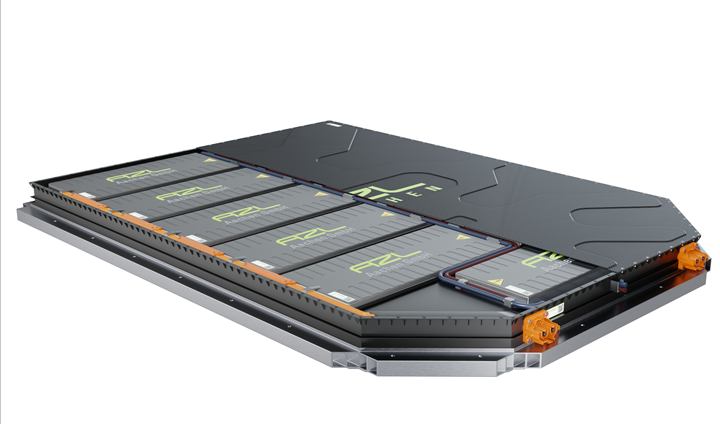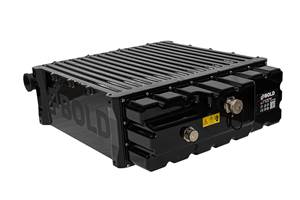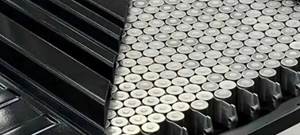AZL Aachen with 46 industry partners successfully complete multi-material battery casings project
Multi-material solutions, including consideration of composites, open up high potential for cost and weight savings for battery casings, with follow-up projects to come in 2022.

Battery casing concept. Photo Credit, all images: AZL
AZL Aachen (Germany), with a total of 46 industrial partners, have reported the successful completion of its project on multi-material battery casings, previously announced in September 2020. The AZL says several different concepts for plastic-based, multi-material battery casings were developed, with which significant weight and cost savings are possible. Throughout the project, consideration of using composites to fulfill various functions was also investigated. Additionally, in the course of the project, two important core topics emerged that are to be dealt with in separate follow-up projects beginning Jan. 26, 2022: bottom impact protection and fire resistance. Further, a project for the development and realization of prototypes is planned for the middle of the year in 2022.
Battery casings are among the key components in electric vehicles (EVs), most of which are usually made of aluminum. It was this challenge that the AZL and its consortium of car manufacturers, automotive suppliers, raw material producers and machine suppliers analyzed. “The enormous response from industry underlines the relevance of the topic,” says project leader Warden Schijve, pleased with the progress and results. According to the AZL, up to 36% weight and up to 20% costs can be saved if multi-material composites are used instead of conventional solutions
Weight and cost saving potentials for different multi-material battery casings compared to aluminum reference casing.
To obtain these results, the AZL, with the cooperation of its partner companies including Audi (Ingolstadt, Germany), Asahi Kasei (Tokyo, Japan), Covestro (Leverkusen, Germany), EconCore (Leuven, Belgium), IPTE (Genk, Belgium), Johns Manville (JM, Denver, Colo., U.S.), Teijin Ltd. (Tokyo, Japan), DSM (Heerlen, Netherlands), Faurecia (Nanterre, France), Formosa (Taipei City, Taiwan), Hengrui (China), Hutchinson (Paris, France), Magna (Aurora, Canada) and Marelli (Corbetta, Italy) first defined five sub-components of a battery casing: The enclosure tray, the bottom protection plate, the crash frame, the cross beams and the enclosure lid. In addition, the partners analyzed a total of 44 market-relevant, existing series components and concepts in more detail and compiled a comprehensive overview of the various standards and requirements at national, international and OEM level. The premise was to achieve the same or even better mechanical performance than conventional solutions. For example, at least the same stiffness, safety in case of side impact, EMI shielding and flame protection should be available. In order to determine alternative solutions, the AZL developed 20 design concepts with different material combinations. To analyze and design the different concepts, more than 500 FEM models were created and more than 1,500 CAE simulations were performed.
“Battery housings are a key component in EVs. In the joint project, the AZL comprehensively investigated the demanding requirements and developed concepts on how plastic-based multi-material solutions can save weight and costs compared to status quo solutions made of metals,” says Dr.-Ing. Florian Meyer, project management mentor on the part of Audi AG’s Technical Development. “The collaboration with the cross-value chain and cross-material class consortium enabled a creative exchange and new impulses. As Audi AG, we were able to use the project voucher included in our AZL Business+ partnership efficiently in this project initiative.”
Composite materials including thermoplastic and thermosets, sheet molding compound (SMC), pultruded profiles, fabrics, unidirectional (UD) materials, sandwich (foam, honeycomb and D-LFT core), as well as long fiber thermoplastics (LFT) and hybrid overmolding (tape + injection molding) were studied to fulfill battery casing functions.
“The project and the enormous response from industry not only show us the relevance of the topic, but also the potential of alternative multi-material composites,” Schijve says, referring to this completed project, as well as the follow-up ones to come. “In addition to individual development projects, we will start on Jan. 26, 2022 ,with two follow-up activities in the format of jointly funded Joint Partner Projects and invite new companies to participate in these projects.”
While follow-up project one deals with an application-related test method and the investigation of the safety of different material combinations for bottom impact protection, follow-up project two focuses on the fire resistance of different materials and material combinations. The aim is to develop test methods that allow impact/fire resistance to be investigated at material level, taking into account the specific requirements of a battery casing in comparison with standard materials.
Related Content
Bcomp ampliTex makes appearance in Cupra EV Cup Bucket seats
The entire Cupra Born VZ line-up features all-natural fiber front seats that highlight functionality, aesthetics and reduced CO2 emissions.
Read MoreOn the radar: Innovations in composite battery enclosures
A look at recently reported design, material and process innovations for composites-intensive battery enclosures, developed to support the ramp-up of EV and AAM vehicles.
Read MoreComposites end markets: Batteries and fuel cells (2024)
As the number of battery and fuel cell electric vehicles (EVs) grows, so do the opportunities for composites in battery enclosures and components for fuel cells.
Read MoreSABIC composite hybrid battery cover enhances EV safety, efficiency
SABIC collaborated with Engel, Siebenwurst, Forward Engineering, Ensinger and Envalior to develop a thermoplastic composite EV battery cover, combining strong structural performance, flame retardancy and design efficiency.
Read MoreRead Next
Cutting 100 pounds, certification time for the X-59 nose cone
Swift Engineering used HyperX software to remove 100 pounds from 38-foot graphite/epoxy cored nose cone for X-59 supersonic aircraft.
Read MoreNext-gen fan blades: Hybrid twin RTM, printed sensors, laser shock disassembly
MORPHO project demonstrates blade with 20% faster RTM cure cycle, uses AI-based monitoring for improved maintenance/life cycle management and proves laser shock disassembly for recycling.
Read MoreCeramic matrix composites: Faster, cheaper, higher temperature
New players proliferate, increasing CMC materials and manufacturing capacity, novel processes and automation to meet demand for higher part volumes and performance.
Read More












